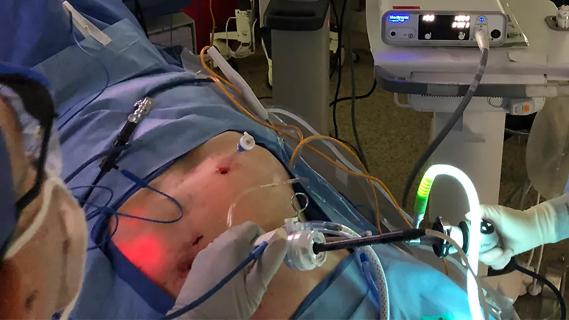Multidisciplinary efforts to refine cerebral hemodynamic goals in a high-risk population

A unique interdisciplinary effort at Cleveland Clinic aims to improve outcomes for patients with cerebral edema secondary to advanced liver failure, with a focus on the underappreciated phenomenon of impaired cerebral autoregulation.
Advertisement
Cleveland Clinic is a non-profit academic medical center. Advertising on our site helps support our mission. We do not endorse non-Cleveland Clinic products or services. Policy
Cerebral edema is a leading cause of morbidity and mortality in patients with acute liver failure (ALF) and acute-on-chronic liver failure (ACLF). In both conditions, cerebral edema impairs cerebral autoregulation (CA), the brain’s ability to maintain cerebral blood flow within a normal range when pressures change.
“The majority of hepatologists and medical intensive care unit (ICU) staff are aware of the risk of cerebral edema when ammonia levels become very high in patients with ALF or ACLF,” says Catherine Hassett, DO, a neurointensive care specialist in Cleveland Clinic’s Cerebrovascular Center. “What is less well understood is the impairment of cerebral autoregulation when patients get to those very high levels.”
The multidisciplinary Cleveland Clinic research team is working to develop optimal cerebral perfusion pressure thresholds based on CA specific to the liver failure population and to also validate noninvasive neuromonitoring methods that could be employed earlier in the course of the neurologic insult.
Dr. Hassett is leading the research team, whose leading members also include critical care medicine specialist Aanchal Kapoor, MD, and hepatologist Christina Lindenmeyer, MD, both of Cleveland Clinic’s medical intensive liver unit. At several professional society meetings this fall, Drs. Hassett and Kapoor presented data illustrating the phenomenon of impaired CA in patients with advanced liver failure in the setting of normal intracranial and cerebral perfusion pressures as measured by invasive intracranial pressure monitoring devices.
Advertisement
“We try to stay within a range of cerebral autoregulation appropriate for each individual,” Dr. Hassett explains. “A lot of neurological ICU research has looked at this in the setting of traumatic brain injury (TBI) and stroke, but we believe we’re the first to look at it in patients with liver failure.”
According to Dr. Kapoor, Cleveland Clinic is one of the few institutions that use invasive intracranial pressure monitors in advanced liver failure patients in whom neurological examination and brain imaging suggest concern for cerebral edema and intracranial hypertension. In most centers, patients with ALF and concerns for cerebral edema are treated prophylactically with hypertonic saline without invasive monitoring.
Ultimately, though, the goal is to establish noninvasive measures to minimize the need for drilling a hole in the skull for placement of a screw, or “bolt,” which must be done exceedingly carefully to avoid infection or injury. “We made a shared decision with neurosurgeons, neurointensivists and hepatology colleagues to place intracranial bolts to measure intracranial pressures and quantify cerebral autoregulation in a systematic and protocolized manner in this very risky patient population,” notes Dr. Kapoor. “That is now allowing us to validate noninvasive tools in anticipation of using those tools instead to monitor and treat this patient population.”
Two studies were conducted involving eight patients with advanced-grade liver failure (three ALF and five ACLF) with grade 4 hepatic encephalopathy. All were on mechanical ventilation, and all had invasive intracranial pressure monitors placed for measuring intracranial pressure.
Advertisement
Dr. Hassett notes that even though the number of patients was small, tens of thousands of data points were collected to enable results powered for detecting statistically significant differences. “Our software gives us continuous physiologic neuromonitoring data recorded on a millisecond basis, so it yields a tremendous amount of data on these patients,” she says. “This is cutting-edge.”
A model-based index for dynamic CA, the pressure reactivity index (PRx), was calculated with the patient’s mean arterial blood pressure (MAP) and intracranial pressure (ICP). An index greater than 0.3 indicated impaired CA.
Over a median 10.8 hours of monitoring time, MAP was 72.1 mmHg and mean cerebral perfusion pressure (CPP) was 65.3 mmHg, both within normal ranges. Mean ICP was 4.95 mmHg, with a higher value among those with ACLF versus ALF (P < 0.001), but again within normal range.
Notably, however, despite the normal values of MAP, CPP and ICP, the CA value was found to be severely impaired in both groups. The mean PRx was 0.5 and was slightly higher for those with ALF versus ACLF (P = 0.02). However, for the two groups combined, 80.7% of the time was spent with the PRx above 0.3, which is the cutoff for impaired CA based on data derived from cerebral edema in the TBI population.
Thus, impaired CA was prevalent in these patients despite normal ICP and CPP. And, due to the degree of CA impairment, optimal values for CPP couldn’t be calculated.
Only two of the eight patients survived with liver recovery. None of the patients underwent liver transplantation.
Advertisement
The second study in the same eight patients compared the PRx with another calculated index of cerebrovascular reactivity, the pressure amplitude index (PAx), both derived after 30 minutes or more of continuous neuromonitoring. Preserved cerebrovascular reactivity, calculated by both PRx and PAx, has been linked to patient outcomes in TBI.
Compared with the 80.7% of time spent in impaired CA as calculated by the PRx, the value was 79.3% with PAx; however, correlation between the two measures was weak and variability was wide. There was no difference in the two indices between the survivors and the deceased.
“These indices have been validated in the TBI population but not in liver failure,” Dr. Hassett notes. “The mechanism for cerebral edema in this population is completely different and the index thresholds may be as well.”
As a next step, Drs. Hassett, Kapoor and their Cleveland Clinic colleagues plan to investigate use of currently available noninvasive neuromonitoring technology, including transcranial Doppler ultrasound and near-infrared spectroscopy, as well as investigational noninvasive ICP monitors that are used in neuro ICU research. These approaches would allow for an autoregulation index to be obtained from waveforms, Dr. Hassett notes, adding that this work to support noninvasive neuromonitoring will be funded in part by a philanthropic donation to Cleveland Clinic’s neurological ICU team from the Analog Devices Foundation.
“It’s likely that when we’re putting an invasive ICP monitor in, it’s too late,” she says. “If we could identify individualized hemodynamic goals for these patients and risk-stratify them sooner with noninvasive monitoring, we might give them a better chance of survival. We’re planning a prospective protocol in the near future.”
Advertisement
Advertisement

Study reveals key differences between antibiotics, but treatment decisions should still consider patient factors

Findings could help clinicians make more informed decisions about medication recommendations

The SPECCIAL study is the first to examine long-term clinical outcomes

Findings also indicate reduced risk of serious liver events

Findings are first to provide underlying explanation, linking the diagnosis to high-immune activation and worse clinical outcomes

Histotripsy is noninvasive and may generate abscopal effect

IBAT inhibitors, elastography and more

New device offers greater tumor control for malignant liver lesions